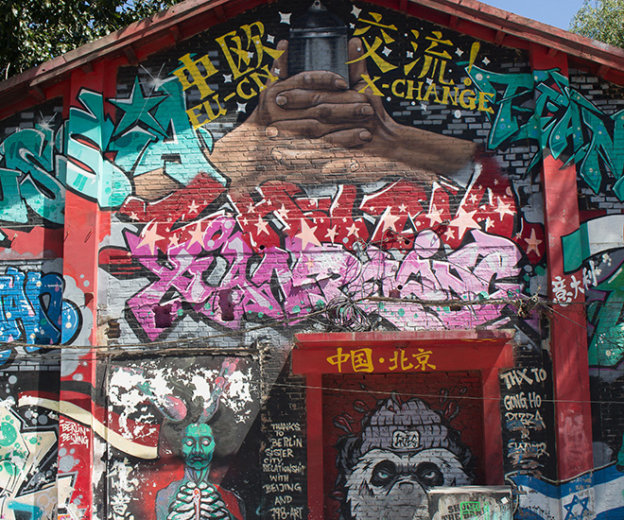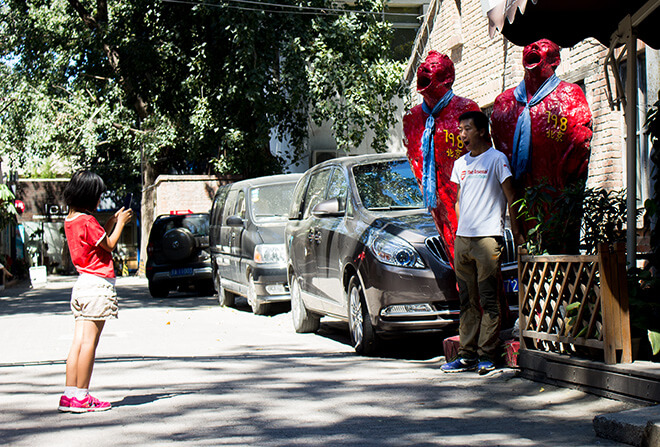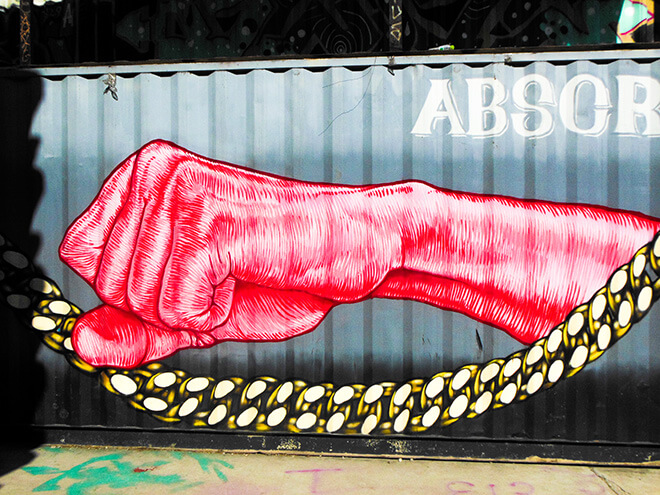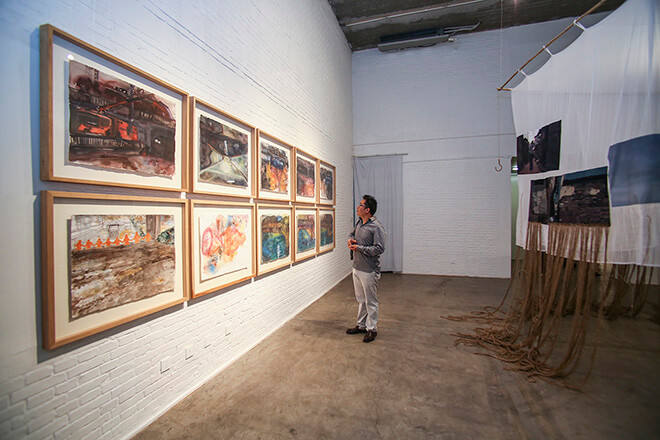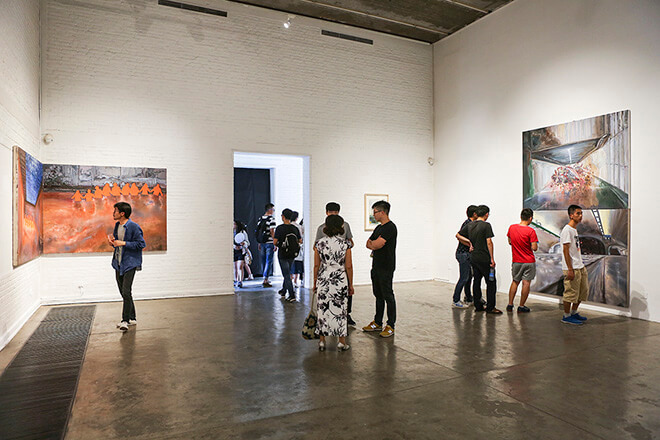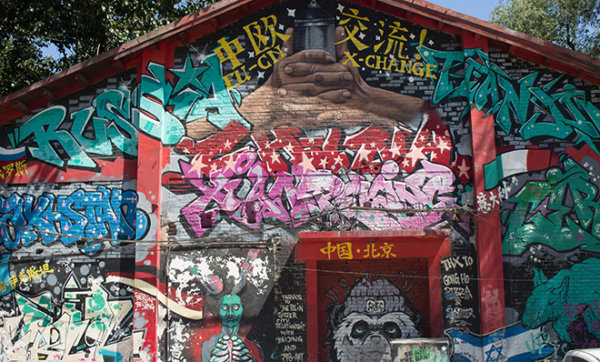
It’s hard to separate the real Beijing from the stereotypes, so deeply have they become ingrained. So it’s all the more unexpected when relic weary visitors learn that Beijing is also a leading centre of modern and contemporary art.
Even before Yue Minjun and Ai Weiwei came into the world spotlight, China had a growing network of underground galleries and artists, sometimes operating without official approval. The subculture that emerged was as subversive as it was eccentric.
The following decades elevated modern art in Beijing from a cultish fringe to a respected form of expression. While the list that follows is far from complete, it offers a brief introduction to some of the most representative spaces in this surprisingly modern spread.
The 798 Arts Zone
The undisputed capital of the modern arts scene is the 798 Art Zone, a half-million square metre complex of red brick at the rim of the Fourth Ring Road, named for its first incarnation as a military factory. Beginning in the 1980s, artists annexed the deserted workshops and squeezed their studios and spaces between the derelict machinery and dripping pipes. Dozens of high-end venues have now set their roots there, as well as many
offshoots and branching from institutions abroad.
Visiting the Art Zone is like stepping into an unusually fashionable alternate reality.
The factory buildings, designed after the austere functionalism of the 1950s – peeling Maoist slogans still visible – have been spray-painted over on every surface, not with slum graffiti but elaborate polychrome murals in intricate detail.
A huge bespectacled octopus menaces passers-by, and a giant green rabbit leaps from one of the windows. The central plaza, appositely named Bauhaus Square, is populated by modern sculptures and ringed around with cutesy cafés and vintage shops. At the south end, a stack of railway cars has been turned
into a panel of psychedelic murals.
Once through the looking-glass, the first sight is a menagerie of twisted animals, while swarms of brass bugs pour down the steps of a gallery nearby. The creatures of this brass menagerie were welded together by Zhu Bingren, China’s brightest sculptor and a descendant of a long line of metalworkers. His otherworldly creations, including orchards of blossoming metal trees and alien animals, are on permanent display at the nearby gallery.
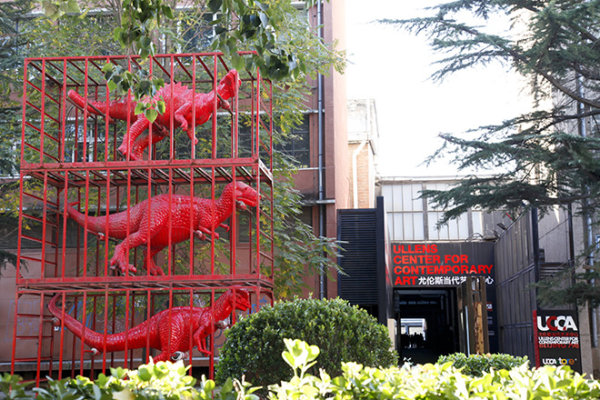
Ullens Center for Contemporary Art
A few steps further, the Ullens Center for Contemporary Art (UCCA) is one of the district’s flagship galleries. Its four spaces, guarded by caged dinosaur sculptures – because why the heck not – host about 15 exhibitions per year, along with film screenings, classes, and lectures.
At the south end of the complex, opposite a row of spray-painted murals, the Beijing Commune has launched some of China’s hottest stars. There is a tongue-in-cheek jab at China’s awkward relationship with idealism and orthodoxy, fitting for a space that has incubated famous upstarts. Its alumni include Yue Minjun, whose laughing self-portraits have become iconic in China’s contemporary art. His Cheshire grin is a sort of mascot for 798, copied in sculptures and paintings throughout the Art Zone.
Caochangdi
- Pekin Fine Arts
- Pekin Fine Arts
Beginning in the 2000s, when rents at the larger Art Zone began to soar, the fringes of the contemporary art movement left in search of greener and cheaper pastures. Its eventual destination was Caochangdi, a proletarian village, which has since become known as “Beijing’s Williamsburg.”
Unlike 798, Caochangdi is not yet part of the tourist circuit and is much more difficult to navigate, not least because many of the streets are unmarked. But despite the rough edges and remote location, the presence of several creative heavyweights has turned the village into a busy laboratory for aesthetic innovation. Most of the showrooms benefit from productive exchanges with artists in Hong Kong, Europe, and around the world.
A gloomy, brooding atmosphere prevails at Pekin Fine Arts, which at the time of writing was occupied by the unsettling monsters imagined by Liu Di. Liu, who won the coveted Lacoste Elysee Prize in 2010, explores the blurry seam between nature and human society. Most of his works explore themes of abnormal growth. His exhibits, ranging from photos to advanced 3D films, are full of ordinary animals ballooned to skyscraper sizes. The huge animals “point to the unreliability of common sense”, the artist writes, a coded reference to China’s sometimes agonising growing pains. The gallery, founded by China veteran Meg Maggio, also has a branch in Hong Kong’s Aberdeen.
The Hutongs
While most of the art scene is in the suburbs, you don’t need to go that far to find good art in the city. Capitalising on the hipster chic of the Drum Tower and other old-style neighbourhoods, many up-and-coming art spaces have opened in the city alongside noodle stalls and bun shops. The inner warrens make an ideal habitat for rising artists, even if they mostly pay in exposure.
In the heart of the old quarter, I: Project Space is more of a workshop than a showroom. Located in a pleasant old-style courtyard, the collective focuses on art creation and exchange. You can attend the third Independent Art Spaces Festival in August, an annual collaboration by small collectives and spaces around the city. The festival is held in spaces ranging from large galleries to private apartments and digital spaces. “In a time where space is not any more necessarily connected with a locality, we want to also show projects of art that happen outside of the institutional system,” says media liaison Antonie Angerer.
At the southern edge of the city, Red Gate Gallery delivers modernity with a unique twist. Instead of framing its art with futurist architecture, the gallery is in a 600-year-old Ming dynasty watchtower, with new works displayed between imperial masonry and arrow-slits. It’s the oldest private gallery in China, which has, through collaboration with international residency programmes, hosted hundreds of international artists. “Some of our leading lights were Su Xinping, Tan Ping, Liu Qinghe, and Sui Jianguo, and each of them has played a major role nurturing the new generation of artists,” says founder Brian Wal.
For something more challenging, the Intelligentsia Gallery has a reputation for bewildering even hard-nosed connoisseurs. Their displays are more like puzzles than artworks, in spaces ranging from empty factories to hourly hotel rooms. “Intelligentsia creates a space for positions and oppositions, for dialogue and contradictions,” explains the collective in the cryptic Intelligentsia Manifesto. We haven’t yet quite figured out what that means, but we’re all in favour.
Words by By Andrew Wincheta.
From: Men’s Folio Malaysia, Jun/July 2017.
